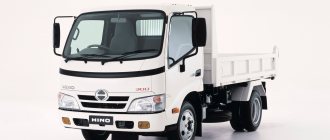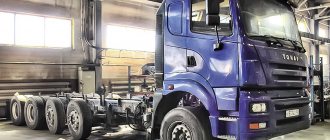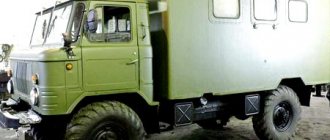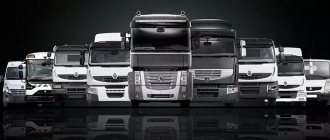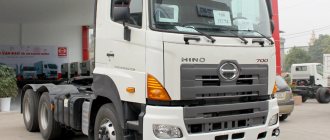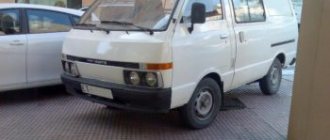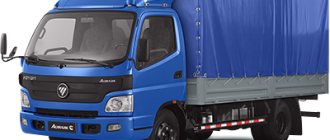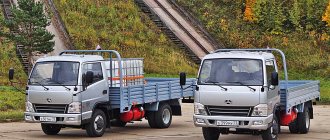Hino 700 is a large-capacity truck with a 6x4 wheel arrangement. The scope of application of these trucks is quite wide and covers such areas as construction, industry, various cargo transportation and much more. The versatility of the model is explained not only by a fairly wide selection of modifications, but also by the possibility of installing any add-ons.
In general, almost all trucks produced by the Japanese manufacturer Hino Motors Ltd (part of the Toyota Corporation) have the highest quality and reliability, which is characteristic not only of the 700 series, but also of other families. The machines have a modern, attractive design, and also have excellent efficiency and high productivity. The installed cabin boasts a high level of comfort and ergonomics for a truck.
Story
Hino Motors Ltd. is a leading company in Japan engaged in the serial production of trucks. The company has existed since 1910 and during all this time it has managed to gain great trust, and as a result, popularity among consumers. This allowed the products of this brand to enter the world market, where now many models of the family create very strong competition with models of Chinese, Russian and some European-made models.
The main concept of the brand is the production of trucks that best meet consumer requirements. But the manufacturer also did not forget about the environment. All vehicles are equipped with economical diesel power plants, which have a minimal polluting impact on the environment.
The Hino 700 family of trucks in Japan is produced under the name Profia, but apart from the steering wheel location, it is no different from the 700 series vehicles.
The trucks were first introduced to consumers in 1981. The cars remained on the market until 1992, and later the second generation was introduced. Even then, they were able to prove themselves well and throughout the years did not reduce the level of quality and reliability. Due to this, new versions of Hino 700 are in quite high demand today, not only in the Japanese market, but also in many others.
The entire Hino 700 family has a universal frame on which a wide variety of superstructures can be installed, thereby expanding the scope of application of these trucks. The most popular versions have become those equipped with an insulated van, a refrigerator, towing equipment, a tank truck, a platform for transporting containers, a crane, a concrete mixer truck, a timber platform and much more. It all depends on the operational requirements.
In 2010, the manufacturer modernized its heavy trucks. Now new power plants have become available to them, which have improved environmental characteristics and more economical fuel consumption. Previously, six-cylinder diesel engines were offered for all models, the volume of which was 10.5 and 12.9 liters. Their power was 300 and 410 horsepower. For truck tractors, slightly modified versions were used, with maximum output power of 350 and 520 horsepower.
In 2011, the truck family was modernized again. To a large extent, the second modernization is associated with the new Japanese law, which defines new requirements for fuel consumption. As a result, the cars received even more economical engines. However, at the same time, their working volume was reduced to 8.8 liters, but the power indicators, on the contrary, became higher - from 350 to 360 horsepower. As for fuel consumption, on average new engines consume up to 24 liters per hundred kilometers.
Advantages of the HINO-700 chassis
- The chassis is manufactured entirely in Japan at the Hino plant in Tokyo Prefecture.
- The chassis frame is durable, riveted and reinforced. Frame spars – profile height 310 mm, shelf width 85 mm, steel thickness 7 mm
- Durable springs with shock absorbers on both axles for heavy loads. Front pack of 11 sheets, rear pack of 12 sheets 90 mm wide
- Availability of ABS
- 6-cylinder diesel engine with a volume of 12.9 liters and a power of 410 hp.
- Common-Rail power system - relatively low fuel consumption compared to other power systems
- Turbocharger (manufactured by the famous GARRETT company) with a mechanism for changing the geometry of the exhaust part (which allows you to obtain boost in a wide speed range)
- Heated main fuel filter, as well as the presence of an additional heated separator, extend engine life
- The generator, water pump, and air conditioning compressor are driven by one serpentine belt with automatic tension, which ensures ease of maintenance
- The FS chassis is equipped with a 7-speed gearbox, 2-7 gears are synchronized
- The SS chassis is equipped with a 16-speed gearbox, fully synchronized
- Availability of decompression engine brake
- Combined cab suspension. Rear – spring on shock absorbers, front – pneumatic on air springs
- Hydraulic cab tilting drive
- Sleeping place for driver's rest
- Galvanic galvanization of the welded cabin + cataphoretic priming before painting + use of high-quality primers, enamels and mastics
Modifications
For consumers, Hino 700 trucks are offered in several variations, namely: chassis, truck tractors, dump trucks and trucks equipped with various superstructures.
The main difference between single trucks is their technical characteristics. There are several versions in total: FH, FN, FP, FR, FQ, FS, FW and GN.
- The model with the FH index has a 4x2 wheel arrangement;
- Modifications FN, FP, FR and GN have a 6x2 wheel arrangement;
- Modifications FQ and FS have a 6x4 wheel arrangement;
- The FW version uses an 8x4 chassis.
Depending on the version, the maximum load capacity of the truck can range from 8800 to 16200 kilograms. The total weight also varies, ranging from 15,600 to 25,000 kilograms.
It is worth noting that the entire family has only three main modified versions, and everything else is just their variations:
Modification FS.
This version is a dump truck using a 6x4 chassis. The power plant of this modification is represented by a powerful six-cylinder diesel engine with turbocharging, an exhaust gas recirculation system (ensures compliance with Euro 4 environmental standards), as well as an intercooler and CommonRail electronic fuel system. With a working volume of 12.9 liters, the power unit used develops a maximum output power of 410 horsepower. On board there is a dump cargo platform with a volume of 16.5 cubic meters. Its length is 5000 millimeters, width 2200, and the height of the sides is 1500. The maximum load capacity of this model reaches 17500 kilograms;
Modification SS.
It is a truck-type tractor. It has an all-metal cabin that can accommodate two people. There is also a fairly comfortable sleeping area inside. For this version, a six-cylinder diesel power plant with a displacement of 12.9 liters was chosen. The maximum output power reaches 450 horsepower. Equipment includes turbocharging, CommonRail electronic fuel system, exhaust gas recirculation system, etc. The engine complies with Euro-4 environmental requirements. The truck itself has a 6x4 wheel arrangement and a total weight of 28,300 kilograms. At the same time, it can pull a semi-trailer with a total weight of up to 60,000 kilograms;
Modification FS.
It is a cargo chassis that can be equipped with a variety of add-ons. It has an all-metal cabin designed for two people. Access to the engine is carried out in the same way as on other trucks of this class, namely by tilting the cab forward. Under the cabin there is a six-cylinder power plant with a displacement of 12.9 liters and a maximum output power of 410 horsepower. In terms of equipment, the engine almost completely copies previous versions. As for the carrying capacity, this modification is capable of withstanding a load of 22,000 kilograms, and its total weight is 30,700 kilograms.
Cabin
Hino 700 is equipped with a fairly spacious cabin. It has an all-metal structure and two seats inside (for the driver and passenger).
The interior features pleasant-to-touch gray plastic elements and fabric upholstery for the driver and passenger seats. The driver's seat has a very ergonomic profile and also has an armrest and lumbar adjustment. In general, the driver’s workplace is quite comfortable, but if his height is more than 185 centimeters, then some inconveniences arise here, since the seat is not adjustable in the horizontal direction.
Externally, this truck came out very stylish and impressive. The cabin has a large radiator grille made of gray plastic and unusual triangular direction indicators. It is worth noting that the latter are also found on lighter families of Hino trucks (300 and 500). The headlights also have a small and neat shape, but this does not affect the lighting efficiency in any way.
Thanks to the large glass area of the cabin, the model has very wide visibility. The number of blind spots has been reduced as much as possible by installing several massive rear-view mirrors. Excellent visibility from the workplace not only makes work safer, but also more comfortable.
If we take into account the tractor unit, the cabin is almost identical, with the exception of some details. For example, there is a sleeping place inside, located behind the backs of the seats. In addition, for operation in conditions of low negative temperatures, an autonomous heating system is provided here.
Specifications
Engine
Depending on the modification, the technical part of the trucks may differ.
For the piece-type tractor, the manufacturer used a six-cylinder diesel power plant with a displacement of 12.9 liters. This engine has a turbocharging system, CommonRail electronic fuel injection and an exhaust gas recirculation system. All this provided it with a maximum output power of 450 horsepower and compliance with environmental standards Euro-3 and Euro-4.
Dump trucks, concrete mixer trucks and other single trucks are equipped with the same six-cylinder diesel engine with a displacement of 12.9 liters. However, the power is already 410 horsepower. It uses almost the same equipment as the previous version. The engine also complies with Euro-3 and Euro-4 environmental standards.
Both engines are in-house development of the manufacturer Hino.
In addition, other motors were previously installed. These were 10.5 liter diesel power plants with a maximum output power of 300 horsepower (for single trucks) and 350 (for truck tractors).
checkpoint
The truck tractor with the SS index has a sixteen-speed manual transmission with synchronizers in all gears, provided by the manufacturer ZF. In addition, this version uses a dry double-disc clutch with a pneumatic booster and a hydraulic drive, as well as rear drive axles with a locking center differential.
The FS version, also known as the dump truck, has a seven-speed manual transmission, which has synchronizers in second, third, fourth, fifth, sixth and seventh gears. A dry single-plate clutch with a pneumatic booster and a hydraulic drive was used here. This gearbox is also installed on other versions of single trucks.
Brake system
Any modification of the Hino 700 truck uses a dual-circuit pneumatic braking system. Drum brakes are installed on each wheel. There are also ABS and ASR systems, which significantly increases the safety of the model.
Chassis
All Hino 700 trucks have a riveted frame, which is based on side members with different sections made of high-strength steel.
At the front, the model is equipped with a dependent suspension with semi-elliptical springs, a transverse stabilizer and a pair of bi-directional hydraulic telescopic shock absorbers.
The rear bogie uses a balancer suspension, which is, in principle, typical of other three-axle trucks. Small leaf springs and shock absorbers are installed here.
Dimensions:
- Total length (tractor tractor) – 7005 mm;
- Total length (dump truck) – 7840 mm;
- Total length (truck chassis) – 10645 mm;
- Full width (tractor tractor) – 2490 mm;
- Full width (dump truck) – 2550 mm;
- Full width (truck chassis) – 2520 mm;
- Cabin height (truck tractor) – 3325 mm;
- Cabin height (dump truck) – 3070 mm;
- Body height (truck chassis) – 3043 mm;
- Wheelbase length (tractor tractor) – 3300 mm;
- The length of the wheelbase of the rear bogie (tractor tractor) is 1310 mm;
- Wheelbase length (dump truck) – 3655 mm;
- The length of the wheelbase of the rear bogie (dump truck) is 1310 mm;
- Wheelbase length (truck chassis) – 5350 mm;
- The length of the rear bogie wheelbase (truck chassis) is 1310 mm;
- Ground clearance (truck tractor) – 210 mm;
- Ground clearance (dump truck) – 245 mm;
- Ground clearance (truck chassis) – 245 mm;
Chassis (suspension, brakes, steering)
The truck is equipped with front and rear drum brakes. The handbrake is designed with spring energy accumulators installed on the rear axles. The model is equipped with a mountain brake. The car has ABS and ASR, as well as a system that automatically adjusts the brake pad clearances. The truck has a dry friction single-plate clutch in its design, equipped with a hydraulic drive and a pneumatic booster.
A dependent wheel with hydraulic shock absorbers and anti-roll bar is installed at the front. The design features of the front suspension include its base on semi-elliptical leaf springs. The design of the rear suspension is not much different from the front: the same semi-elliptical springs and hydraulic shock absorbers.
Peculiarities
The Hino 700 family of trucks has a fairly high level of safety. This is provided by a stability control system, a preventive safety system, as well as an effective braking system with ABS.
Everything inside the cabin is quite comfortable and ergonomic. A liquid crystal display is installed on the central panel, which displays the necessary information about the current state of the machine. In addition, as an additional option, the manufacturer offers the installation of a monitor with a navigation system and several cameras that significantly improve visibility when working in cramped conditions.
The entire fuel system of the car, including fuel injectors, is not picky about the quality of the diesel fuel being poured. What is especially valued in Russian realities. In terms of maintenance, Hino 700 trucks are quite simple and straightforward. The use of a modular design greatly facilitated any repair work. Thanks to all this, the owner can independently fix this or that malfunction without resorting to the help of specialized services, which is undoubtedly a big plus.
What is also worth mentioning about maintenance is that to check the level of fluids (cooling system, clutch, windshield washers), the driver will not need to tilt the cab, since the outputs of these elements are brought into the cabin. The dashboard itself has a built-in block of fusible relays and fuses.
Among the shortcomings, many owners note that on a new truck, the first malfunctions can occur at a mileage of 30 thousand kilometers, but it happens later. Often this is an average gearbox, and it can fail even with careful operation. This is explained by the peculiarity of the oil pump in the gearbox, which is capable of pumping only in one direction. Failure of this element can subsequently lead to more serious damage, such as, for example, the middle and rear gear pairs.
After overcoming a mileage of 50 thousand kilometers, it is necessary to monitor the jet thrusts, since various breakdowns often occur in them. However, this already depends on the operating conditions of the truck.
If maintenance and inspections are carried out in a timely manner, then the Hino 700 will be truly reliable and durable equipment.
Reviews from owners and drivers
- I have a Hino 700 dump truck with a load capacity of 15 tons and a 400-horsepower 13-liter diesel engine, which rips and rushes in a wide speed range. A very powerful and lifting dump truck with universal capabilities. During four years of operation, I have never regretted that I “got in touch” with a used Japanese truck. The machine is used to deliver agricultural products from the fields, so it has to deal with a variety of road surfaces - from gravel to M4. In addition, I am also dealing with flights from the south beyond the Urals. Regarding maintenance, it should be noted that the Hino 700 is relatively inexpensive compared to other foreign cars. Original filters are affordable and available everywhere. The chassis is impressively durable, except that once I had to replace the bushings and pins on the springs front and rear. The shock absorbers also need to be replaced, but this is all a minor thing. Electrical equipment, axles and engine are functioning properly. The powerful heater blows efficiently in all directions - depending on how you set it up. Perhaps the cabin is always warm due to the small volume, but I find it spacious. Fuel consumption is between 27-35 liters per 100 km. The current mileage is 400 thousand km - quite a lot already, but I don’t even hesitate about selling it. The level of comfort is normal only by budget standards, but the most important thing is that there is everything you need, including air conditioning and a radio.
- An excellent tractor, which I have been using for the second year. There will be no serious problems with it if this machine is treated appropriately - timely service and content with only original components and consumables. The power of the 400-horsepower 12.9-liter diesel engine is sufficient with reserve, including when driving uphill. Fuel consumption is 30 liters per 100 km when empty, as well as 40 liters under a load of around 15 tons. The engine is surprisingly unpretentious to the quality of our diesel fuel. And yet, I am convinced that you should not save on fuel, so I only go to proven gas stations. The comfort in the cabin is specific, but by cargo standards it will do just fine. The chair is installed on an air cushion and is also heated. The small sleeping place was clearly designed primarily for short Japanese people. But it’s also quite suitable if you really need to take a break. In winter it is neither hot nor cold - there is no need to open the windows. Despite the cheap finishing materials, everything is flawlessly assembled and fitted - I did not notice any uneven gaps. In terms of decoration, the car is of course far from modern “Europeans”, but it suits me. I recommend this workhorse to everyone.
- I work on a Hino 700 flatbed truck with an awning. I have a version with a trailer. Not a bad car for cargo transportation of 15 tons. The body was installed in Naberezhnye Chelny. At the same time, we attached a full-size spare tire - there was a place for it in the side part. In addition, the electrics and air were brought to the right place. In general, no details here - in Chelny, the car was thoroughly modified for us, everything was as we wanted, without punctures or flaws. I have a 9-meter body - in principle, a typical medium-duty truck. In winter it was cold in the cabin, so it was necessary to insulate it. Comfort, equipment and ergonomics are no different from European trucks of the 90s, so the Japanese decided to save money here. Fuel consumption with a 15-ton load is 35 liters per 100 km, and with 20 tons a 400-horsepower diesel engine consumes 45 liters. When empty, it yields 30 liters. I must admit, the car is far from being a track car - its gear ratios are too large for a 7-speed gearbox. Based on this, at speeds in the range of 1250-1400 (this range is considered the most economical) you can accelerate to no more than 70 km/h. If you reach 90 km/h, then in this case the speed will already be at 1750 rpm, and then the consumption will rise to 50 liters. The suspension does not shake - both under load and without. Withstands 20 tons without problems. The car holds the road well - it doesn’t pull to the side, you don’t have to steer, there are no problems with directional stability. Stability is acceptable on asphalt, snow or ice. On climbs, the 400-horsepower diesel engine pulls like a steam locomotive.
- In our transport company, we have five Hino 700 dump trucks. All the vehicles are well-maintained, with decent mileage, but in good condition - clean and well-maintained. We use these dump trucks to cover asphalt routes and quarries. But to tell the truth, the Hino 700’s stiff suspension is more tuned to the asphalt. On rough terrain, the car shakes noticeably - even a seat with an air cushion cannot help. The technology itself does not shine with reliability, because most of the components and assemblies come from the 90s - nevertheless, they are well studied and time-tested. The cars were pleasing with trouble-free driving only for the first 30 thousand km. Then problems arose, among which I would note the low performance of the middle gearbox, which cannot withstand heavy loads - it literally falls apart. It is necessary to modify the main pair of the middle and rear gearbox. Jet thrusts are designed for 50 thousand km, no more. The same applies to the springs - on two of the five cars they broke four times, and the same number were changed (twice front and twice rear). Something tells me that this dump truck is more suitable for transporting paper waste, since sand and crushed stone seriously increase the load, and the machine has to “sweat.” I will also note the mediocre directional stability of all five cars. On the dirt road you have to constantly steer, and there is swaying when turning. When unloading, the vehicle even tries to turn around - one of the dump trucks even collapsed on the first day of operation. But there are no complaints about the engine at all - 400 horses are enough for long climbs. Consumption is around 35-40 liters. At the same time, there is a shortage of spare parts, which are also expensive. For example, one main pair costs 190 thousand rubles.
- I have a used 2004 Hino 700 dump truck. The impressions are mostly positive, but it is impossible to do without problems. This is obvious given the colossal load and long distances - I cover kilometers through Novosibirsk, Krasnoyarsk, Chita, Ulan-Ude, etc. However, the reliability of the car is the envy of domestic cars, as well as some European analogues. Load capacity is 15-20 tons, and fuel consumption is 35-45 liters depending on load, speed and operating conditions. With a 400-horsepower diesel engine you can climb climbs without problems. The engine is not prone to overheating, the gearbox works smoothly and without jerking. Maneuvering the Hino 700 is a pleasure. But we must admit that the car is much better prepared for asphalt pavement than country roads. This is a plus in terms of stability, but also a minus in terms of cross-country ability. But I drive mostly on asphalt, and on gravel it shakes noticeably. Electrics, airbag sensors, ABS and other systems are not protected by anything and are susceptible to splashes, which is why they malfunction and fail. The salt simply eats it up - hmmm, apparently the Japanese don’t understand our harsh Russian winters. And yet, with the necessary modifications, the car remains strong and reliable.
Additionally
Equipment
| Equipment | DLX |
| Exterior | |
| The front bumper is painted in the color of the cabin, metal | + |
| 2-part side view mirrors with spherical additional section | + |
| Front curb mirror | + |
| Right curb mirror | + |
| Chassis | |
| Air filter with safety element | + |
| Spare wheel | + |
| Tire inflation hose, with pressure gauge | + |
| Lockable fuel filler cap | + |
| Tow hooks front and rear | + |
| Chassis electrical and lighting equipment | |
| Front fog lamps (integrated into the main headlights) | + |
| Rear fog lamp | + |
| Pneumatic system dryer heating | + |
| Heated side view mirrors | + |
| Fuel filter heating | + |
| Hydraulic cab tilting drive | + |
| Interior | |
| Ergonomic driver's seat with air suspension | + |
| Adjusting the driver's seat length | + |
| Adjusting the driver's seat backrest | + |
| Adjusting the lumbar support of the driver's seat | + |
| Driver's seat armrest | + |
| Fabric seat upholstery | + |
| Sleeping mattress | + |
| Power windows for side doors | + |
| Heated driver's seat | + |
| Air conditioner | + |
| Increased capacity interior heater | + |
| AM/FM audio system | + |
| 2 audio system speakers | + |
| Handles on the A-pillars for easy entry into the cab | + |
| 3-point seat belts for driver and front passenger with inertia tensioner | + |
| Driver seat belt indicator | + |
| Reverse traffic alarm | + |
| central locking | + |
| Control key for center differential locking (for SS tractor chassis - center differential and 2 cross-axle differentials) | + |
| Engine operation indicator in economy mode on the tachometer scale | + |
| Headlight range control with manual adjustment | + |
| Variable speed windshield wipers | + |
| Glass in the rear of the cab | + |
| Rubberized floor covering | + |
| Ceiling consoles for documents | + |
| 2 sun visors | + |
| 2 hooks for clothes on the rear wall of the cabin | + |
| 2 ceiling lamps for reading maps | + |
| Ceiling lamp, large | + |
| Folding middle passenger seatback with document tray in the backrest | + |
| Storage pockets in cab doors | + |
| Cigarette lighter | + |
| Ashtrays in front doors, removable | + |
| 2 cup holders in the front panel | + |
| Spare parts and accessories | |
| Extended tool kit (Jack, wheel wrench, 3 screwdrivers, pliers, 6 wrenches, oil gun, hammer) | + |
Warranty and maintenance
| Name of works | Service interval (x 1,000 km) | ||||||||||
| 5 | 30 | 60 | 90 | 120 | 150 | 180 | 210 | 240 | 270 | 300 | |
| Engine | |||||||||||
| Engine oil and oil filter | Z | Z | Z | Z | Z | Z | Z | Z | Z | Z | Z |
| Intake, exhaust and exhaust systems, EGR system (leaks, tightening of bolts of system parts) | P | P | P | P | P | P | P | P | P | P | P |
| Engine cooling system (leaks) | P | P | P | P | P | P | P | P | P | P | P |
| Coolant | Replacement every 200,000 km | ||||||||||
| Radiator cap (operability) | P | P | P | P | P | ||||||
| Valve clearances | P | P | P | P | P | ||||||
| Pre-heating system | P | P | P | P | P | ||||||
| Drive belts of internal combustion engine units | P | P | P | P | P | P | P | P | P | P | P |
| Fuel system | |||||||||||
| Air filter | P | Z | Z | Z | Z | Z | Z | Z | Z | Z | Z |
| Fuel tank, cap, pipes and their connections (leaks, damage, fasteners) | P | P | P | P | P | P | P | P | P | P | P |
| Fuel filter (coarse and fine) | Z | Z | Z | Z | Z | Z | Z | Z | Z | Z | |
| Brake system | |||||||||||
| Brake drums and brake linings | P | P | P | P | P | P | P | P | P | P | |
| Brake hoses, tubes (leaks, damage, fasteners) | P | P | P | P | P | P | P | P | P | P | P |
| Brake chamber rod (stroke, free stroke) | P | P | P | P | P | P | P | P | P | P | |
| Brake master cylinder, solenoid valves, brake chambers. | P | P | P | P | P | P | P | P | P | P | |
| Dehumidifier | P | P | P | P | P | ||||||
| ABS (sensors, solenoid valves) | P | P | P | P | P | P | P | P | P | P | |
| Drier filter | Replacement every 60,000 km or 12 months | ||||||||||
| Parking brake control valve | P | P | P | P | P | P | P | P | P | P | |
| Transmission and Clutch (HX07) | |||||||||||
| Manual transmission oil, filter | Z | P | Z | P | Z | P | Z | P | Z | P | Z |
| Hoses, seals, boots, protective covers (leaks, condition) | P | P | P | P | P | P | P | P | P | P | P |
| Clutch | |||||||||||
| Clutch fluid (level, leaks) | P | P | Z | P | Z | P | Z | P | Z | P | Z |
| Hoses, seals, boots, protective covers (leaks, condition) | P | P | P | P | P | P | P | P | P | P | P |
| Differential | |||||||||||
| Differential oil (level) | Z | P | Z | P | Z | P | Z | P | Z | P | Z |
| Filter | Z | Z | Z | Z | Z | Z | |||||
| Breather (serviceability, cleanliness) | P | P | P | P | P | P | P | P | P | P | P |
| Steering | |||||||||||
| Steering elements | P | P | P | P | P | P | P | P | P | P | |
| Power steering fluid (leaks, level) | P | P | Z | P | Z | P | Z | P | Z | P | Z |
| Power steering reservoir filter | P | Z | P | Z | P | Z | P | Z | P | Z | |
| Steering rods, pivots | WITH | WITH | WITH | WITH | WITH | WITH | WITH | WITH | WITH | WITH | WITH |
| Tires (wear, damage, pressure), wheels | P | P | P | P | P | P | P | P | P | P | |
| Steering Connections | WITH | WITH | WITH | WITH | WITH | WITH | WITH | WITH | WITH | WITH | WITH |
| Suspension | |||||||||||
| Front and rear suspension | P | P | P | P | P | P | P | P | P | P | P |
| Injection of suspension, driveshaft, outboard bearing, seat | WITH | WITH | WITH | WITH | WITH | WITH | WITH | WITH | WITH | WITH | WITH |
| Bolts for fastening the propeller shaft, outboard bearing. | P | P | P | P | P | P | P | P | P | P | |
| Suspension bearing, cardan shaft crosspieces. | P | P | P | P | P | P | P | P | P | P | |
| Wheel bearings (grease replacement) | WITH | WITH | WITH | WITH | WITH | ||||||
| Rearranging wheels | P | P | P | P | P | ||||||
| Bolts and nuts on the chassis, superstructures (covering) | P | P | P | P | P | P | P | P | P | P | P |
| Electrical equipment | |||||||||||
| External and internal lighting, sound signals | P | P | P | P | P | P | P | P | P | P | P |
| Dashboard | P | P | P | P | P | P | P | P | P | P | P |
| Battery connections | P | P | P | P | P | P | P | P | P | P | P |
| Batteries | P | P | P | P | P | P | P | P | P | P | P |
| ECU diagnostics using HINO DX | P | P | P | P | P | P | P | P | P | P | |
| Air conditioning system | |||||||||||
| Ventilation and air conditioning system | P | P | P | P | P | P | P | P | P | P | |
| Air conditioner filter | P | P | P | P | P | P | P | P | P | P | |
| Cabin and superstructure | |||||||||||
| Clips, fasteners, hinges, locks | P | P | P | P | P | P | P | P | P | P | |
| Windshield wipers and washers | P | P | P | P | P | P | P | P | P | P | P |
| Cabin lift mechanism | P | P | P | P | P | P | P | P | P | P | P |
| Cabin lift fluid | Replace every 24 months | ||||||||||
| Work in agreement with the client | |||||||||||
| Wheel alignment angles | P | P | P | P | P | P | P | P | P | P | |
| Rubber hoses for air and hydraulic systems | Replace every 24 months | ||||||||||
| Rubber hoses and rubber steering parts | Replace every 24 months | ||||||||||
| Brake air hoses | Replace every 24 months | ||||||||||
| Brake chamber diaphragm | Replace every 24 months | ||||||||||
| Rubber hoses for manual transmission cooling system | Replace every 24 months | ||||||||||
| Rubber fuel hoses | Replace every 48 months | ||||||||||
| Standard hours of FS chassis | 6 | 10,2 | 15 | 10,2 | 15 | 10,2 | 15 | 10,2 | 15 | 10,2 | 15 |
| Standard hours of SS chassis | 5,6 | 10,2 | 14,6 | 10,2 | 15 | 10,2 | 14,6 | 10,2 | 15 | 10,2 | 14,6 |
Maintenance operations: (standard cost/hour varies among dealers)
P – check, adjust if necessary, tighten, clean, replace. Z – replace. C – lubricate.
* - if available (depending on configuration)
Service warranty book (0.6 Mb)
Optional equipment
If you need to install additional equipment, you can contact our specialist:
- liquid engine pre-heater
- dry principle cabin heater
- spoiler
- parking sensors
- Rear View Camera
- hydraulic platform for rear unloading, etc.
We offer a large selection of high-quality additional equipment from different manufacturers and models with an appropriate installation guarantee.
Since 2013, a cooperation agreement has been in force between the HINO distributor and the representative office of the German manufacturer of autonomous automotive heating systems EBERSPACHER in Russia, allowing HINO customers to receive a high-quality product, as well as be confident in the high installation culture of HINO dealership employees who have been trained by EBERSPACHER.
One of the main types of products from EBERSPACHER Climate Control Systems is an autonomous heating system for the engine and vehicle interior. Hydronic liquid engine heaters and Airtronic air heaters have long been known on the market and cover a wide range of applications.
It is very easy to set the most comfortable temperature in the car interior and control the operation of the preheater using control devices. Products of control devices of the EasyStart family supplied to the Russian market include devices from a simple timer (EasyStart Timer, EasyStart Select) to remote controls (EasyStart Remote, EasyStart Remote Plus) and GSM modules (EasyStart Call, EasyStart Text).
EBERSPACHER liquid heaters operate independently of the engine and have the double advantage of preheating the vehicle interior and the engine.
The heater heats the fluid in the engine cooling system. The EBERSPACHER's own heater pump circulates coolant through a small cooling circle into which the interior heat exchanger is connected. An additional heater function allows you to autonomously start the interior heater fan when a certain temperature is reached. And in summer, the EBERSPACHER Hydronic heater can easily be converted into an independent ventilation system.
All HINO Series 700 models are equipped with EBERSPACHER Hydronic M II - D12W liquid heaters.
| Specifications | Hydronic M II – D12W | |
| Nominal Application | 24 V | |
| Coolant | Antifreeze, coolant | |
| Fuel | Diesel | |
| Fuel consumption per 30 min. fuel heating, (l) | 0,65 | |
| Fuel flow control | High | Small |
| Fuel Flow (W) | 12 000 | 1 200 |
| Average electrical power consumption (W) | 132 | 34 |
| Dimensions (L x W x H), (mm) | 331 x 138 x 174 | |
| Weight, kg) | 6,2 | |
Heater operating cycle
When receiving a start signal from the control device, the heater performs the following actions:
- Checking all heater systems and components for operability and diagnosing vehicle battery charging.
- The combustion chamber blower (pre-ventilation of the combustion chamber), the ceramic glow pin (preheating), and the fuel pump (supply fuel to the ceramic glow pin) are turned on.
- The process of ignition of the fuel-air mixture occurs and a flame is formed.
- The coolant is heated due to heat transfer from the heater heat exchanger.
- Depending on the heat needs, the heater is adjusted in several stages: maximum, low.
- Due to the circulation of heated coolant, the engine and cabin interior are warmed up (heat transfer from the coolant through the vehicle heat exchanger).
